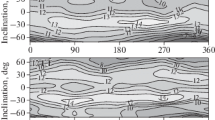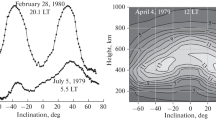Abstract
The equatorial anomaly dynamics in the winter solstice is studied based on data from topside sounding of the ionosphere from the Interkosmos-19 satellite for high solar activity. This is the final study on the construction of the pattern of equatorial anomaly variations under conditions of high solar activity. Changes in the equatorial anomaly structure with local time and longitude are considered in detail. It is shown that the anomaly begins to form at ~0800 LT during the creation of the winter northern crest, but the well-developed equatorial anomaly is formed only by 1000–1100 LT. The daytime maximum of the equatorial anomaly development is reached at 1200 LT. The foF2 value above the equator and the degree of the equatorial anomaly development (equatorial anomaly intensity, EAI) at 1200 LT vary with longitude according to changes in the vertical plasma drift velocity W. Three harmonics are observed in the longitudinal variations in W, foF2, and EAI at this time. The EAI increases up to the diurnal maximum 1.5−2.0 h after the evening W burst. Longitudinal variations in foF2 at 2000 LT are also associated with the relevant variations in W, in which two harmonics are revealed. The degree of equatorial anomaly development drops after the evening peak but equatorial anomaly is still well-developed at midnight and is completely absent at 0500–0700 LT. The EAI at different moments of local time differs rather strongly for different longitudinal sectors. The average position of northern crest is ~25° of the geomagnetic inclination I, and the southern crest is at ~–30° I. During the day, the winter crest is higher than the summer crest; by night-time, it is quite the opposite. Thus, a well-expressed equatorial anomaly is observed from 1000–1100 to 0000–0200 LT during the winter solstice.










Similar content being viewed by others
REFERENCES
Balan, N. and Bailey, G.J., Equatorial plasma fountain and its effects: Possibility of an additional layer, J. Geophys. Res., 1995, vol. 100, no. 11, pp. 21421–21432. https://doi.org/10.1029/95JA01555
Bellchambers, W.H. and Piggott, W.R., Ionospheric measurements made at Halley Bay, Nature, 1958, vol. 182, pp. 1596–1597. https://doi.org/10.1038/1821596a0
Chen, Y., Liu, L., Le, H., Wan, W., and Zhang, H., Equatorial ionization anomaly in the low-latitude topside ionosphere: Local time evolution and longitudinal difference, J. Geophys. Res., 2016, vol. 121, pp. 7166–7182. https://doi.org/10.1002/2016JA022394
Eccles, D. and King, J.W., A review of topside sounder studies of the equatorial ionosphere, Proc. IEEE, 1969, vol. 57, no. 6, pp. 1012–1018. https://doi.org/10.1109/PROC.1969.7145
Fejer, B.G., Jensen, J.W., and Su, S.-Y., Quiet time equatorial f region vertical plasma drift model derived from ROCSAT-1 observations, J. Geophys. Res., 2008, vol. 113, A05304. https://doi.org/10.1029/2007JA012801
Hopkins, H.D., Longitudinal variation of the equatorial anomaly, Planet. Space Sci., 1972, vol. 20, no. 12, pp. 2093–2098. https://doi.org/10.1016/0032-0633(72)90065-7
Horvath, I. and Essex, E.A., The Weddell Sea anomaly observed with the TOPEX satellite data, J. Atmos. Sol.-Terr. Phys., 2003, vol. 65, pp. 693–706. https://doi.org/10.1016/S1364-6826(03)00083-X
Huang, Y.-N. and Cheng, K., Solar cycle variations of the equatorial ionospheric anomaly in total electron content in the Asian region, J. Geophys. Res., 1996, vol. 101, no. 11, pp. 24513–24520. https://doi.org/10.1016/0021-9169(94)00147-G
Jackson, J.E., The reduction of topside ionograms to electron-density profiles, Proc. IEEE, 1969, vol. 57, no. 6, pp. 960–976. https://doi.org/10.1109/PROC.1969.7140
Karpachev, A.T., Characteristics of the global longitudinal effect in a nighttime equatorial anomaly, Geomagn. Aeron., 1988, vol. 28, no. 1, pp. 46–49.
Karpachev, A.T., Diurnal and longitudinal variations of the structure of an equatorial anomaly during equinoxes according to Intercosmos-19 satellite data, Geomagn. Aeron. (Engl. Transl.), 2018, vol. 58, no. 3, pp. 407–419. https://doi.org/10.1134/S0016793218030076
Karpachev, A.T., Variations in the structure of the equatorial anomaly during the summer solstice according to the Interkosmos-19 satellite, Geomagn. Aeron. (Engl. Transl.), 2020, vol. 60, no. 2, pp. 224–235. https://doi.org/10.1134/S0016793220020061
Karpachev, A.T., Gasilov, N.A., and Karpachev, O.A., Morphology and causes of the Weddell Sea anomaly, Geomagn. Aeron. (Engl. Transl.), 2011, vol. 51, no. 6, pp. 812–824.
Kil, H., Oh, S.-J., Paxton, L.J., and Fang, T.-W., High-resolution vertical e?b drift model derived from rocsat-1 data, J. Geophys. Res., 2009, vol. 114, p. A10314.
King, J.W., Airglow observations and the decay of the ionospheric equatorial anomaly, J. Atmos. Terr. Phys., 1968, vol. 30, pp. 391–402. https://doi.org/10.1016/0021-9169(68)90110-4
King, J.W., Olatunji, E.O., Eccles, D., and Newman, W.S., The integrated electron content in the equatorial ionosphere, J. Atmos. Terr. Phys., 1967, vol. 29, no. 11, pp. 1391–1396. https://doi.org/10.1016/0021-9169(67)90230-9
Klimenko, M.V., Klimenko, V.V., Karpachev, A.T., Ratovsky, K.G., and Stepanov, A.E., Spatial features of Weddell Sea and Yakutsk anomalies in foF2 diurnal variations during high solar activity periods: Interkosmos-19 satellite and ground-based ionosonde observations, IRI reproduction and GSM tip model simulation, Adv. Space Res., 2015, vol. 55, no. 8, pp. 2020–2032. https://doi.org/10.1016/j.asr.2014.12.032
Lei, J., Thayer, J.P., and Forbes, J.M., Longitudinal and geomagnetic activity modulation of the equatorial thermosphere anomaly, J. Geophys. Res., 2010, vol. 115, A08311. https://doi.org/10.1029/2009JA015177
Liu, H. and Watanabe, S., Seasonal variation of the longitudinal structure of the equatorial ionosphere: Does it reflect tidal influences from below?, J. Geophys. Res., 2008, vol. 113, A08315. https://doi.org/10.1029/2008JA013027
Liu, H., Stolle, C., Forster, M., and Watanabe, S., Solar activity dependence of the electron density at 400 km at equatorial and low latitudes observed by CHAMP, J. Geophys. Res., 2007, vol. 112, A11311. https://doi.org/10.1029/2007JA012616
Lockwood, G.E.K. and Nelms, G.L., Topside sounder observations of the equatorial anomaly in the 75°W longitude zone, J. Atmos. Terr. Phys., 1964, vol. 26, no. 5, pp. 569–580. https://doi.org/10.1016/0021-9169(64)90188-6
Lyon, A.J. and Thomas, L., The F2-region equatorial anomaly in the African, American and East Asian sectors during sunspot minimum, J. Atmos. Terr. Phys., 1963, vol. 25, no. 7, pp. 373–386. https://doi.org/10.1016/0021-9169(63)90170-3
Matuura, N., Characteristics of global distribution of foF2, Sol. Terr. Environ. Res. Jpn., 1981, vol. 5, pp. 35–38.
Oh, S.-J., Kil, H., Kim, W.-T., Paxton, L.J., and Kim, Y.H., The role of the vertical E×B drift for the formation of the longitudinal plasma density structure in the low-latitude F region, Ann. Geophys., 2008, vol. 26, no. 7, pp. 2061–2067. https://doi.org/10.5194/angeo-26-2061-2008
Pancheva, D. and Mukhtarov, P., Global response of the ionosphere to atmospheric tides forced from below: Recent progress based on satellite measurements global tidal response of ionosphere, Space Sci. Rev., 2012, vol. 168, nos. 1–4, pp. 175–209. https://doi.org/10.1007/s11214-011-9837-1
Rajaram, G., Structure of the equatorial F-region, topside and bottomside—a review, J. Atmos. Terr. Phys., 1977, vol. 39, no. 9, pp. 1125–1144. https://doi.org/10.1016/0021-9169(77)90021-6
Ram, S.T., Su, S.-Y., and Liu, C.H., FORMOSAT-3/ COSMIC observations of seasonal and longitudinal variations of equatorial ionization anomaly and its interhemispheric asymmetry during the solar minimum period, J. Geophys. Res., 2009, vol. 114, A06311. https://doi.org/10.1029/2008JA013880
Rao, B.C.N., Some characteristic features of the equatorial ionosphere and the location of the F-region equator, J. Geophys. Res., 1963, vol. 68, no. 9, pp. 2541–2549. https://doi.org/10.1029/JZ068i009p02541
Rao, C.S.R. and Malthotra, P.L., A study of geomagnetic anomaly during I.G.Y., J. Atmos. Terr. Phys., 1964, vol. 26, no. 11, pp. 1075–1085. https://doi.org/10.1016/0021-9169(64)90093-5
Rastogi, R.G., Chandra, H., Sharma, R.P., and Rajaram, G., Ground-based measurements of ionospheric phenomena associated with the equatorial electrojet, Indian J. Radio Space Phys., 1972, vol. 1, no. 2, pp. 119–135.
Rush, C.M., Rush, S.V., Lyons, L.R., and Venkateswaran, S.V., Equatorial anomaly during a period of declining solar activity, Radio Sci., 1969, vol. 4, no. 9, pp. 829–841. https://doi.org/10.1029/RS004i009p00829
Sastri, J.H., Equatorial anomaly in F-region—a review, Indian J. Radio Space Phys., 1990, vol. 19, no. 4, pp. 225–240.
Sharma, R.P. and Hewens, E.J., A study of the equatorial anomaly at American longitudes during sunspot minimum, J. Atmos. Terr. Phys., 1976, vol. 38, no. 5, pp. 475–484. https://doi.org/10.1016/0021-9169(76)90004-0
Thomas, L., The F2-region equatorial anomaly during solstice periods at sunspot maximum, J. Atmos. Terr. Phys., 1968, vol. 30, no. 9, pp. 1631–1640. https://doi.org/10.1016/0021-9169(68)90011-1
Tsai, L.-C., Liu, C.H., Hsiao, T.Y., and Huang, J.Y., A near real-time phenomenological model of ionospheric electron density based on GPS radio occultation data, Radio Sci., 2009, vol. 44, RS5002. https://doi.org/10.1029/2009RS004154
Walker, G.O., Longitudinal structure of the F-region equatorial anomaly—a review, J. Atmos. Terr. Phys., 1981, vol. 43, no. 8, pp. 763–774. https://doi.org/10.1016/0021-9169(81)90052-0
Walker, G.O. and Chen, C.S., The diurnal variation of the equatorial anomaly in the topside ionosphere at sunspot maximum, J. Atmos. Sol.-Terr. Phys., 1976, vol. 38, no. 7, pp. 699–706. https://doi.org/10.1016/0021-9169(76)90108-2
Walker, G.O., Ma, J.H.K., and Golton, E., The equatorial ionospheric anomaly in electron content from solar minimum to solar maximum for South East Asia, Ann. Geophys., 1994, vol. 12, nos. 2–3, pp. 195–209. https://doi.org/10.1007/s00585-994-0195-0
Yizengaw, E., Moldwin, M.B., Sahai, Y., and Rodolfo, J., Strong postmidnight equatorial ionospheric anomaly observations during magnetically quiet periods, J. Geophys. Res., 2009, vol. 114, A12308. https://doi.org/10.1029/2009JA014603
Yue, X., Schreiner, W.S., Kuo, Y.-H., and Lei, J., Ionosphere equatorial ionization anomaly observed by GPS radio occultations during 2006–2014, J. Atmos. Sol.-Terr. Phys., 2015, vol. 129, no. 7, pp. 30–40. https://doi.org/10.1016/j.jastp.2015.04.004
Zeng, Z., Burns, A., Wang, W., Lei, J., Solomon, S., Syndergaard, S., Qian, L., and Kuo, Y.-H., Ionospheric annual asymmetry observed by the cosmic radio occultation measurements and simulated by the TIEGCM, J. Geophys. Res., 2008, vol. 113, A07305. https://doi.org/10.1029/2007JA012897
Zhao, B., Wan, W., Liu, L., and Ren, Z., Characteristics of the ionospheric total electron content of the equatorial ionization anomaly in the Asian–Australian region during 1996–2004, Ann. Geophys., 2009, vol. 27, no. 10, pp. 3861–3873. https://doi.org/10.5194/angeo-27-3861-2009
Funding
This work was supported by the Presidium of the Russian Academy of Sciences (Program No. 28) and the Ministry of Education and Science of the Russian Federation (Project KP 19-270).
Author information
Authors and Affiliations
Corresponding author
Additional information
Translated by M. Samokhina
Rights and permissions
About this article
Cite this article
Karpachev, A.T. Diurnal and Longitudinal Variations in the Equatorial Anomaly for Winter Solstice According to Interkosmos-19 Satellite Data. Geomagn. Aeron. 61, 29–43 (2021). https://doi.org/10.1134/S0016793221010060
Received:
Revised:
Accepted:
Published:
Issue Date:
DOI: https://doi.org/10.1134/S0016793221010060




